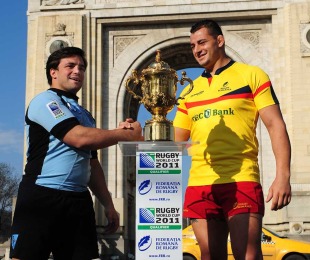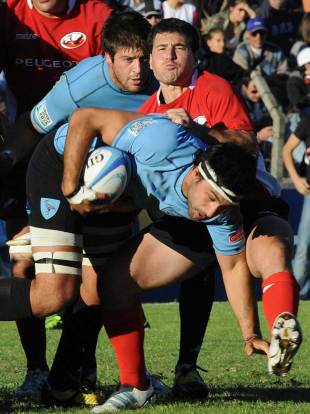|
2015 Rugby World Cup
'Beating the USA would be wonderful'
Frankie Deges
November 12, 2013

Castres' Rodrigo Capo-Ortega is holding a torch for Uruguayan rugby at Castres in France © Getty Images
Enlarge
The importance of Rugby World Cup can never be underestimated. No fewer than 82 teams started their quest for a place at England 2015 and, with less than two years to go, seven places are still up for grabs. And Uruguay, a veteran of two previous tournaments, will be doing everything possible to grab one of those elusive spots. Los Teros won a game apiece in Wales 1999 (v Spain) and Australia 2003 (v Georgia) and then came agonisingly close to qualifying for France 2007 (missing out by a solitary point in the two-game playoff against Portugal) and again for New Zealand 2011 (losing narrowly to Romania, also in the repechage). That international in Bucharest three years ago was the last game for a proud servant of Uruguayan rugby, Pablo Lemoine, who now takes charge of national teams and the growing high performance unit in Montevideo. A big, powerful prop who played at the highest level in both England and France, Lemoine is back in the Uruguayan capital where he spends long hours at the Charrúa Stadium, plotting the rebirth of rugby in his beloved country. Not an easy task considering the small population but rugby has been embraced in Uruguay by a dedicated group now for more than 100 years. "We put in long hours but we are full of passion for what we are doing with the whole project here," Lemoine says from the stadium now known as Tierra de Teros (Land of Teros).

Uruguay lost out to Romania for a spot in the 2011 World Cup
© Getty Images
Enlarge
The Charrúa Stadium, located in the outskirts of the city, close to the rugby-dominated Carrasco neighbourhood, has been leased to the Uruguayan Rugby Union for 10 years and what was a crumbling stadium, coming apart at the seams due to lack of maintenance, has now become the comfortable home and fortress of the URU and its high-performance centre. "At our new home, we can have everything centralised, including our offices and our players," explains URU Director Sebastián Piñeyrúa, himself a former Tero coach. When the finals of the local tournament were played, "the stadium had more than 6,000 spectators and it was a great atmosphere. This is now attracting a lot of support and sponsors which in turn allows us to work harder and more effectively." Lemoine heads a team that includes fellow coaches, fitness trainers, doctors and physiotherapists to ensure players have all they need. He said: "I wish I could have had something like this in my playing days. It is not the perfect scenario - far from it - but this spurs us to work harder every day." At the Charrúa Stadium, Under-16s and Under-17s start their road into high performance with the hope of playing for the three main national teams: the Under-20s who have again qualified for the IRB Junior World Rugby Trophy next year, the national Sevens team and then the full national side. "It is a mapped plan and what is important is that players then go back to their clubs and share what they learnt with us," says Piñeyrúa. Referees are also working at the high-performance centre, with their current number one Joaquín Montes now a full international referee, having been appointed for duty in the upcoming November international series.

Uruguay's Juan Ormaechea is halted against Chile in May
© Getty Images
Enlarge
The flow of information is something that is being worked on, both internally and externally. They maintain a good working relationship with their counterparts across the border in Argentina and, at home, it's important that everyone involved in Uruguayan rugby is kept up to date so they can sing from the same hymn sheet. Rugby Sevens is also growing thanks to Olympic Games inclusion for 2016 in Río de Janeiro. The iconic Brazilian city is only a short flight away and the dream of being represented at that event has inspired a plan, headed by Luis Pedro Atchard, that has the full support of the national government and the Olympic Solidarity Fund. Los Teros Sevens played at Rugby World Cup Sevens 2013 in Moscow and were the only team in South America to defeat Argentina, when they won the CONSUR Sevens last year. The women's Sevens scene is also growing and the national team are now a top four side in a region dominated by Brazil. As Los Teros prepare for a Test-match at home against Spain, and fresh from participation in the IRB Americas Rugby Championship, it is the goal of qualifying for Rugby World Cup 2015 that puts everything into perspective. The dates for the all-important two-leg Americas playoff against the USA are set - March 22 at home and March 29 away - and they will work hard to ensure the Charrúa is a fortress that day. With a growing playing population (8,500 active players, of which 5,500 are registered) this is a Union working for the future. Led by former international prop and coach Marcelo Callandra, there are three other former Union presidents in the 11-man council, with a fourth working tirelessly with them. "Qualifying for Rugby World Cup 2015 would reaffirm that the processes in place are bearing fruit," says Lemoine. All these plans have been long in planning but for the past year, work done has been massive, both structurally and on the field. For everyone involved, despite how hard it may be, beating the USA Eagles to qualify directly would be great. Lemoine concludes "Going through the repechage is long, tiring and expensive so beating the USA would be wonderful for us. However, whatever route we take, if it gets us to England, it will be worth our time and efforts." This article originally appeared on IRB.com © ESPN Sports Media Ltd
|
Live Sports
Communication error please reload the page.
-
Football
-
Cricket
-
Rugby
-
- Days
- Hrs
- Mins
- Secs
F1 - Abu Dhabi GP
Abu Dhabi Grand Prix December 11-131. Max Verstappen ()
2. Valtteri Bottas (Mercedes)
3. Lewis Hamilton (Mercedes)
4. Alexander Albon ()
5. Lando Norris ()
6. Carlos Sainz Jr ()
-
ESPNOtherLive >>
Golf - Houston Open
Snooker - China Open
Tennis - Miami Open

